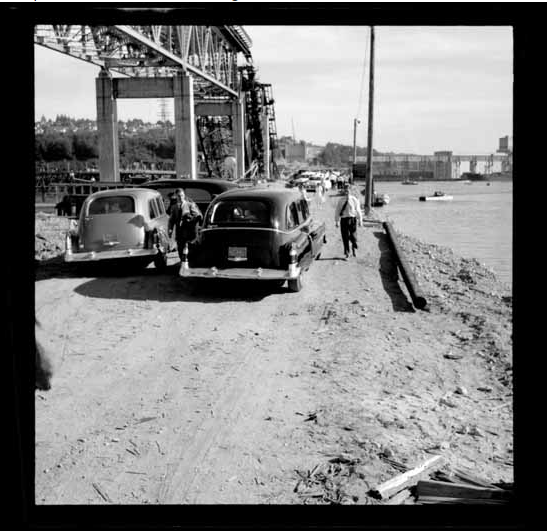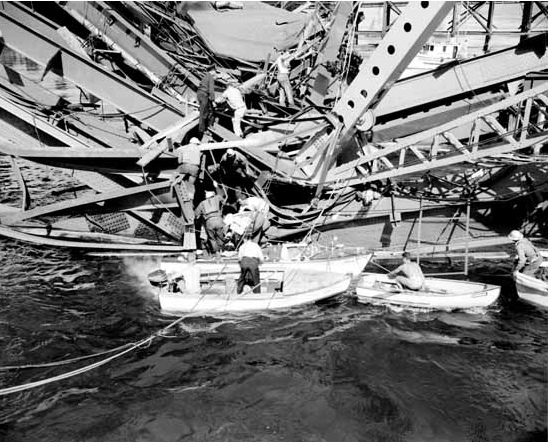The Second Narrows Bridge Collapsed on June 17, 1958, tossing 79 workers into Burrard Inlet and killing 18 of them.

Sounded like an explosion:
Some described the noise of the bridge collapsing into the Second Narrows as gunfire or an explosion, others as a rumble or a loud snapping sound. On June 17, 1958 at 3:40 p.m., people from all over Vancouver stopped to listen, as two spans collapsed, tossing 79 workers into Burrard Inlet and killing 18 of them.
Bill Moore was working on the bridge that day. “There were rivets snapping off and steel grinding against steel. We looked for a place to hide. There was no place to go. Some of the overhead steelwork crashed down on top of the pier and toppled into the water. Scaffolding fell around us,” he told a reporter. “I didn’t see very much but I could hear what was going on. Then everything was still. I’ve heard about ‘deafening silences.’ Now I know what they’re like.”
The massive rescue operation that followed was modelled after a worst-case scenario plane crash at YVR. Some of the men were identified by the brand of cigarettes that they smoked.

Lost a Diver:
Phil Nuytten, the North Vancouver entrepreneur, scientist and inventor of the Newtsuit, was only 17 at the time, and one of two divers sent to recover the bodies. The other diver, Len Mott, 27, became the nineteenth person to die on the job as a result of the bridge collapse.
This is a small part of Nuytten’s story that I’ve taken from an oral history at North Vancouver Archives.

“It was pretty macabre. The tool belts had pulled these guys down and they were standing on the bottom. Their upper torso was buoyant because they had life jackets on, but the tool belts were heavier than the lifejacket would support so they were standing on the bottom, with their arms and their hair facing in the direction of the current. They looked like they were walking, but they were long dead,” said Nuytten. “We found one guy who was crushed in a girder and there was no way to get him out. He was actually smashed in there. So an apprentice commercial diver named Lenny Mott was to try to burn this guy out of this girder and he wound up drowning.”

In 1994, the bridge’s name changed to the Ironworkers Memorial Second Narrows Crossing to honour those who died on the job that day.
The following sources were used for this post:
Eric Jamieson’s Tragedy at Second Narrows; How Come I’m Dead? by Glen McDonald (former Vancouver Coroner), and North Vancouver Archives
Related:



27 comments on “The Second Narrows Bridge Collapse”
I remember when the bridge collapsed! My aunt and uncle lived on Eton Street at Renfrew and you could
see the wreckage of the bridge from their front porch!
The noise must have been incredible
I remember my aunt saying that it was!
It was quite a sight to see, with the spans in the water!
There is the legend, recorded by Matthews in the City Archives, that the problems at Second Narrows were caused by the jinx of “Hwa-Hwoi-Hwoi,” an islet in the middle of the channel “that was the dwelling place of numerous evil spirits”, which was dynamited in 1923. The old road-rail bridge built in 1925 was knocked out by freighters twice, in 1930 and 1979; Ironworkers Memorial was by far a worse disaster. We should hope those bad vibes have ended because of the number of tankers using the narrows – a situation that may only become worse.
I’ve never heard this story! Yes, let the bad vibes be gone
I was 15 at the time & lived on Keith Rd & the Blvd . I remember hearing siren after siren of the ambulances transporting men to the hospital on 13th , wondering what had happened .
I was 14 then and living in the King Edward and Fraser st. area. My friends father drove us kids down for a look see. In the early 70’s I was in the General Hospital recovering from an operation and the man in the bed beside me was recovering from an ongoing back problem due to his original injury he received while working during the bridge collapse. He ended up in the water and was picked up by a rescue boat.
I now live at 17th and Grand Blvd.
Wow, what a tragedy. I didn’t even know about this. I know men died building the Lions Gate Bridge. There are men buried in the Hoover Dam. I know that too. I lived in Vegas. There is a memorial to them. About nine men.
No one is buried in the Hoover dam ! Over 100 people died building it but no one is buried in it. http://www.usbr.gov/lc/hooverdam/history/essays/fatal.html
Concrete on the dam increased at a rate of 2″ per pour. That a little difficult to lose a body in.
You’re right. Urban legend.
My dad was a rescue diver for the dnd he was a member of the
Dnvfd i have a pic of him doing his best too help
I would love to see that photo!
Hello, my father was the Bill Moore you mentioned. I am so astonished to read this. You describe exactly what my dad told me over the years. He rarely spoke of the day the bridge came down, it had a profound effect on him for the rest of his life. He passed away on June 17,1994. He had suffered a stroke days earlier and was unable to verbally communicate but he kept tapping his wrist watch. My sister Sandy, figured out that Dad was asking for the date. That was June 16, he gave us the biggest smile and in the early hours of June 17 he squeezed our hands for the last time and passed away. Thank you for writing this.
Sad, but lovely story, thanks so much for stopping by Cheryl.
Wow, how incredible. So very sorry for your loss.
Just read all the comments and yes it was a sad day for so many poor souls with me included . My Company had the contract for the concrete work and I was on East Hastings Street heading for the bridge which was about 5 mins away. It was a deafening sound but it only lasted a few seconds as the whole thing went down. To access the north side it was necessary to cross the old bridge alongside which was known as “the bridge of sighs” as it was so often open for river traffic causing long delays to both road and rail traffic. I knew some of the men who perished , most of whom worked for Dominion Bridge and there were two who were painters and worked for Boshard. I also knew the Resident Engineer and his young Australian Engineer who both went down with the bridge and perished. These were without exception fine and dedicated people and the loss of these men was and still is a tragedy . Also it was devastating for Colonel Swan of Swan Wooster and Associates who designed the bridge and who was wrongly initially blamed for the collapse. Colonel Swan also lost his son on the Patullo Bridge which he also designed
Very interesting connections
An interesting footnote to this is that the young Swan, an engineering student at the time, and working a summer job checking rivets at the time, lost his footing on a girder that had been smeared with grease………………….. possibly as a prank by iron workers not pleased by the students diligence.
The young Australian engineer was a friend of my fathers and he was terribly missed.
I was 12 years old at the time and had just walked home from school (Hollyburn) in West Van. We were outside and we thought the 9:00 gun had gone off by accident. My grand mother would never travel over the bridge. She said ” It has fallen down once, it could fall down again”
Interesting photos.
I had always thought the collapse was somewhere mid-channel; but now I see that they hadn’t even reached the main crossing.
I was age six. I still remember my father coming home that day home in shock. He worked in Engineering Dept on 18th floor of BC Electric Building. He had binoculars in his office. He did not see the actual collapse but he did see the immediate aftermath.
He had worked besides the job site inspecting power line placements just a week or two before.
I was working at Swan Wooster when the Bridge Collapsed, our Project Engineer in charge of the Bridge Design and Supervision, BillC told us that Dominion Bridge had refused to let him review their calculations for temporarily installed supports (also called False Work) and after the Collapse he found the Calculation error.
In your included diagram, you show “False Bent N4 composed of Piles, Bottom Grillage, Top Grillage, and Bent Post. This is where the Calculation Fault Occurred. There would have been a pair of False Bents, one under the West Chord and the other under the East Chord. In the ‘50s Engineers used Slide Rules which didn’t give a Decimal Point so the Engineer had to do separate decimal calculations.
BillC told us that the Dominion Bridge’s Assistant Engineer had calculated 9Kips for Lateral Displacement when it should have been 90Kips (a Kip is 1000 pounds). The error would have been in the “Grillage” in your diagram.
Both Dominion Bridge’s Engineer and Assistant Engineer were killed in the Collapse.
Thanks so much for the explanation Charles! It’s a bit much for non-mathematical brain to process, but I’m sure others will really appreciate the information.
The song steel men by jimmy dean was produced shortly after the collasps rest in piece my cousin kevin duggen
That was a terrible and tragic day, i love that you share these photos.
[…] The Second Narrows Bridge Collapse […]
[…] officiated over the Inquest of 18 men who were killed when the Second Narrows Bridge collapsed while under construction in 1958. And, he was in charge when CP Flight 21 blew up over […]